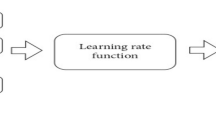Abstract
In this paper the classic momentum algorithm for stochastic optimization is considered. A method is introduced that adjusts coefficients for this algorithm during its operation. The method does not depend on any preliminary knowledge of the optimization problem. In the experimental study, the method is applied to on-line learning in deep auto-encoders, and outperforms manually tuned coefficients. The method makes on-line learning a fully parameter-free process and broadens the area of potential application of this technology.
Access this chapter
Tax calculation will be finalised at checkout
Purchases are for personal use only
Similar content being viewed by others
Notes
- 1.
Actually [17] experimented with \(\lambda _{\max } \in \{0.9, 0.99, 0.995, 0.999\}\). In all cases but for Faces the best choice was \(\lambda _{\max }=0.99\). For Faces it was the second best choice, and the best was \(\lambda _{\max }=0.995\).
References
Behera, L., Kumar, S., Patnaik, A.: On adaptive learning rate that guarantees convergence in feedforward networks. IEEE Trans. Neural Networks 17(5), 1116–1125 (2006)
Bhaya, A., Kaszkurewicz, E.: Steepest descent with momentum for quadratic functions is a version of the conjugate gradient method. Neural Networks 17, 65–71 (2004)
Hinton, G.E., Salakhutdinov, R.R.: Reducing the dimensionality of data with neural networks. Science 313, 504–507 (2006)
Jacobs, R.A.: Increased rates of convergence through learning rate adaptation. Neural Networks 1(4), 295–308 (1988)
Kathirvalavakumar, T., Subavathi, S.J.: Neighborhood based modified backpropagation algorithm using adaptive learning parameters for training feedforward neural networks. Neurocomputing 72, 3915–3921 (2009)
Kushner, H.J., Yin, G.: Stochastic Approximation Algorithms and Applications. Springer-Verlag, New York (1997)
Martens, J., Grosse, R.: Optimizing neural networks with kronecker-factored approximate curvature. In: Proceedings of the 32th International Conference on Machine Learning, pp. 573–582 (2015)
Nesterov, Y.: A method of solving a convex programming problem with convergence rate o(1/sqr(k)). Sov. Math. Dokl. 27, 372–376 (1983)
Pearlmutter, B.A.: Fast exact multiplication by the hessian. Neural Comput. 6(1), 147–160 (1994)
Polyak, B.T.: Some methods of speeding up the convergence of iteration methods. USSR Comput. Math. Math. Phys. 4, 1–17 (1964)
Qian, N.: On the momentum term in gradient descent learning algorithms. Neural Networks 12, 145–151 (1999)
Robbins, H., Monro, S.: A stochastic approximation method. Ann. Math. Stat. 22, 400–407 (1951)
Schaul, T., Zhang, S., LeCun, Y.: No More Pesky Learning Rates. In: International Conference on Machine Learning (ICML) (2013)
Schraudolph, N.N., Giannakopoulos, X.: Online independent component analysis with local learning rate adaptation. Adv. NIPS 12, 789–795 (2000)
Silva, F.M., Almeida, L.B.: Acceleration techniques for the backpropagation algorithm. In: Almeida, L.B., Wellekens, C.J. (eds.) EURASIP 1990. LNCS, vol. 412, pp. 110–119. Springer, Heidelberg (1990). doi:10.1007/3-540-52255-7_32
Sutskever, I.: Training recurrent neural networks. Ph.D. thesis, University of Toronto (2012)
Sutskever, I., Martens, J., Dahl, G., Hinton, G.: On the importance of initialization and momentum in deep learning. In: Proceedings of the 30th International Conference on Machine Learning (ICML 2013). vol. 28, JMLR Workshop and Conference Proceedings, pp. 1139–1147 (2013)
Yu, X., Wang, B., Batbayar, B., Wang, L., Man, Z.: An improved training algorithm for feedforward neural network learning based on terminal attractors. J. Global Optim. 1–14, September 2010
Zak, M.: Terminal attractors in neural networks. Neural Networks 2, 259–274 (1989)
Author information
Authors and Affiliations
Corresponding author
Editor information
Editors and Affiliations
Rights and permissions
Copyright information
© 2017 Springer International Publishing AG
About this paper
Cite this paper
Wawrzyński, P. (2017). Parameter-Free On-line Deep Learning. In: Szewczyk, R., Zieliński, C., Kaliczyńska, M. (eds) Automation 2017. ICA 2017. Advances in Intelligent Systems and Computing, vol 550. Springer, Cham. https://doi.org/10.1007/978-3-319-54042-9_54
Download citation
DOI: https://doi.org/10.1007/978-3-319-54042-9_54
Published:
Publisher Name: Springer, Cham
Print ISBN: 978-3-319-54041-2
Online ISBN: 978-3-319-54042-9
eBook Packages: EngineeringEngineering (R0)




